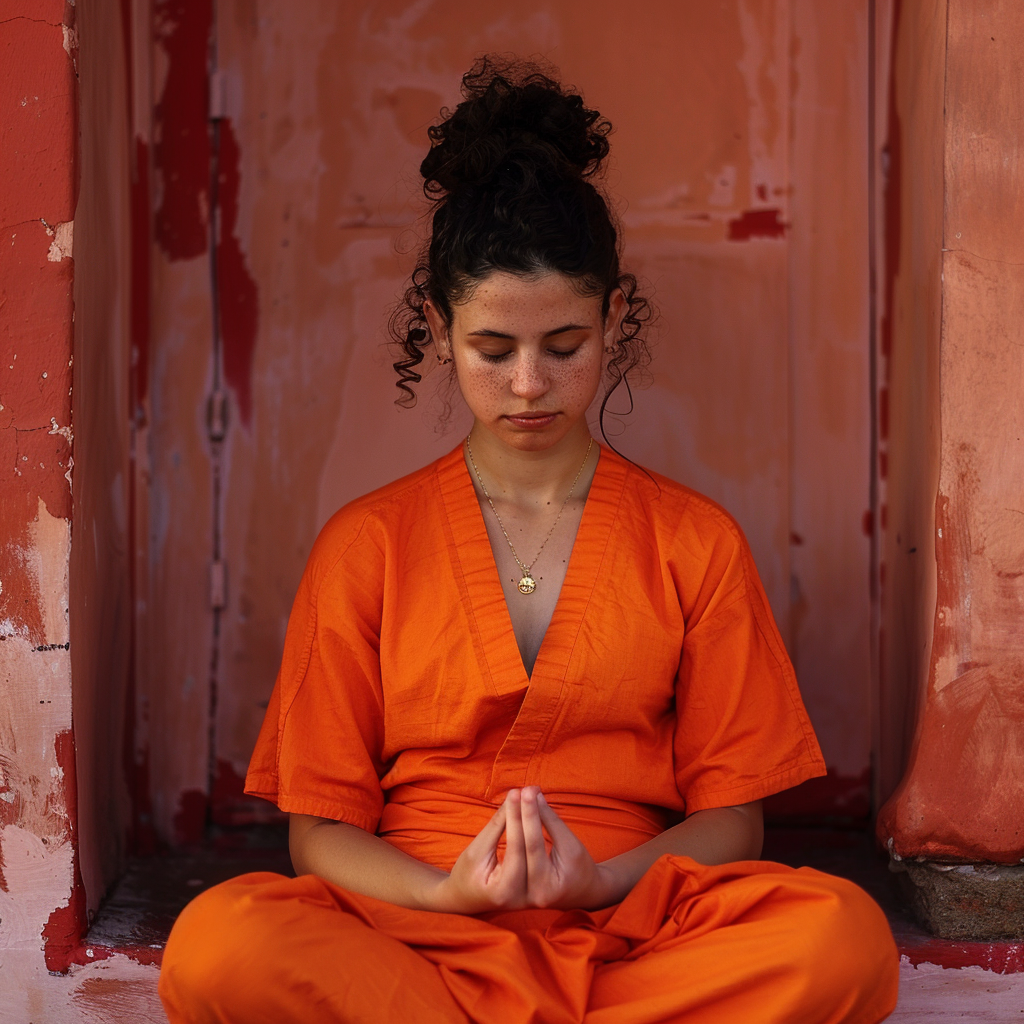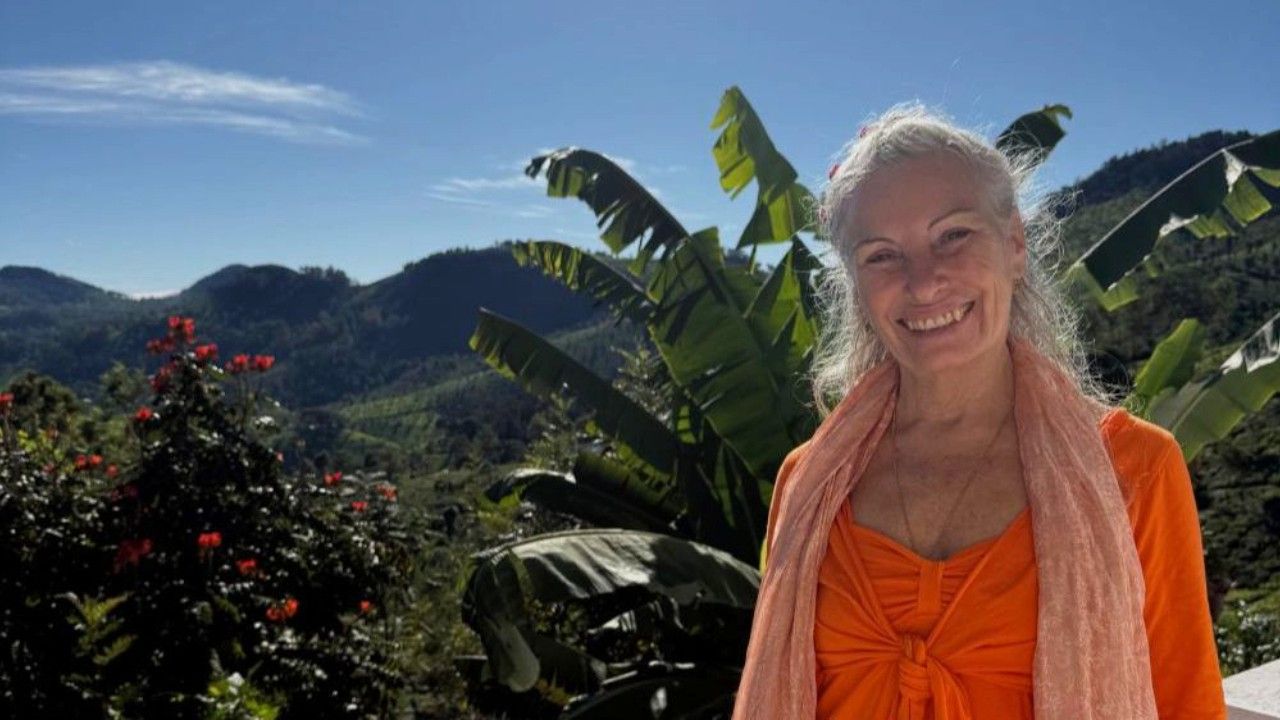What Is Tantra? A Guide to Understanding This Sacred Tradition
Jul 05, 2024
Tantra. Just the word alone conjures up images of contorted bodies, ritualistic chanting, and mind-bending spiritual practices. Tantra isn't just about the sensual aspects that often make headlines (although, we'll get to that later). It's a vast and ancient philosophy that encompasses everything from spiritual enlightenment to personal empowerment.
So, join me as we peel back the layers of this sacred tradition, one mind-altering revelation at a time. Whether you're a seasoned seeker or a curious newcomer, I promise you'll walk away with a newfound appreciation for the depths of Tantra. Who knows, you might even discover a few juicy secrets to spice up your life along the way!
What Is Tantra?
View this post on Instagram
Tantra is about more than just sex, despite what you may have heard. At its essence, Tantra is a sacred tradition that honors the divinity within each of us and all aspects of the human experience.
For over 26 years, I immersed myself in the Tantric philosophies of India before moving to Europe in 1999. There, I was amazed to find how misunderstood and oversimplified Tantra had become in the Western world.
This article aims to shed light on the true depth and transformative potential of the Tantric path - one that weaves together meditation, emotional openness, sensual awakening, and sacred ritual into an ecstatic embracing of our full and vibrant humanity as a portal to the divine.
Tantra's methods don't bypass our raw humanness, but provide a map for transmuting those parts of ourselves we might shun into the deepest spiritual nectar
Classical Tantra
Tantra has its roots in the spiritual traditions of India and South Asia, with its earliest textual references dating back over a millennium ago. The historical development of classical Tantra was influenced by various Hindu and Buddhist philosophies, synthesizing elements from Shaivism, Shaktism, Vaishnavism and Yoga.
At its core, classical Tantra teaches that the material world and divine consciousness are inseparably united. Rather than renouncing the body and material existence as an impediment to spiritual liberation, Tantra embraces all aspects of embodied life as an opportunity for realizing one's divine nature. Core practices include meditation, visualizations, mantra recitation, elaborate ritual ceremonies, as well as unorthodox methods like transgressive actions intended to transcend societal norms.
Some of the key source texts and scriptures that codified the teachings of classical Tantra include the Kularnava Tantra, Vigyana Bhairava Tantra, Mahanirvana Tantra and the Buddhist Guhyasamaja Tantra. These esoteric and ancient texts expound upon tantric metaphysics, deities, mantras, yantras, mudras and other multifaceted practices within various tantric lineages and traditions. The Kaula tantric tradition in particular was known for its transgressive methods and veneration of female embodiment and energy.
Neo Tantra
While classical tantra has ancient roots, Neo Tantra emerged as a modern interpretation and application of tantric principles in the 20th century, especially in the West. As Eastern spiritual traditions met with the social movements and changing values of the 1960s-70s counterculture, certain aspects of Tantra were adopted and recontextualized in novel ways.
Neo Tantra differs from its classical Indian predecessors in several key ways. Whereas classical Tantra was steeped in complex rituals, deities, and esoteric symbolism, Neo Tantra tends to be more simplified and accessible. There is also a greater emphasis on human sexuality, relationships and personal growth compared to the emphasis on spiritual transcendence in the classical traditions.
Some of the prominent figures who helped shape Neo Tantra include my teacher, Osho, who taught incorporating tantric teachings of mindfulness and meditation into everyday life including sexual experiences. In the West, teachers like Margot Anand, Jeffrey Hopkins and David Deida began synthesizing modern relationships, sexuality and personal growth with Tantric principles. Popular Neo Tantric movements likeStreeTantra, SourceTantra and InnerTantra incorporated these contemporary approaches.
Misconceptions About Tantra

As a female teacher of tantric philosophy, I can't tell you how exhausting it gets constantly debunking the rampant myths and misconceptions about what Tantra actually entails. If I had a dollar for every time someone has slyly asked me if I practice some kind of tantric "adultery arts," I could retire to a private island right now.
Let me be absolutely clear - Tantra has nothing to do with sexual promiscuity or hedonistic indulgence. This misconception that it's all about unbridled eroticism is not just misguided, but cheapens Tantra's profound spiritual depth.
Then there are those who hear the word "Tantra" and instantly jump to the conclusion that it promotes some kind of new-age, polyamorous free-for-all. While Tantra does help couples cultivate polarity and energetic intimacy, trying to crudely map it onto the modern "open relationship" concept completely misses the point. Tantra's aim isn't to endorse promiscuity, but to reveal the unified ground of divine consciousness within our embodied nature.
I also have to routinely dispel the myth that there are strict delineations between so-called "White Tantra, Red Tantra, and Black Tantra" paths. This is an utter fabrication that has no basis in tantric traditions. All genuine tantric paths ultimately point toward the same awakened awareness, even if their methods can be quite divergent and seemingly contradictory.
Some people believe Tantra constitutes its own distinct religion, like Buddhism or Hinduism. This is simply not true. Tantric philosophies and practices have intertwined with various spiritual traditions like Shaivism, Vaishnavism, Buddhism, and even Jainism over the centuries. But Tantra itself has never been a standalone formalized religion.
It's also immensely frustrating when people conflate Tantra with some sleazy "tantric massage" parlor gimmicks. While embodied practices can potentially have a place in tantric work, reducing this enormously profound tradition to some cheap trend for a "happy ending" is enormously disrespectful to its sacred roots.
Perhaps the most pernicious myth I constantly have to confront is the association of Tantra with black magic or evil occult forces. This belief likely stems from cultural fears around Tantra's historically transgressive nature that could seem shocking from the outside. But the truth is, tantric paths were always oriented around revealing the inherent divinity within all aspects of human experience - even if the methods looked radically unconventional.
Ma Ananda Sarita’s Core Insights on Tantra

- Tantra is based on methods of meditation. These methods explore the whole range of human life experience. By applying a witnessing consciousness and loving devotion to anything in life, it will be revealed in its divine essence. A witnessing consciousness is aligned with the masculine aspect while love and devotion is aligned with the feminine aspect. All of us have an inner male and inner female. As we explore Tantra, our inner male / female aspects come into balance. This in turn brings balance to the outer male and outer female.
- The tantric path I share is an invitation to unveil the deepest perfection within all aspects of your human experience - even those parts you have been taught are mundane, unspiritual or taboo. Tantra's methods of meditation do not bypass or transcend your messy, earthly existence, but fully lean into it as the very lifeblood of the sacred.
- The great tantric voyage is one of learning to apply a poised, witnessing awareness - the lucid masculine principle - while simultaneously opening to an attitude of devoted, loving embrace toward your experience - the radiant feminine. It is through this masterful union of insightful clarity and vulnerability that you can alchemize all traits and energies, no matter how unsavory they appear, into portals of liberation.
- Each and every one of you contains an inner male and inner female - an innate dance of consciousness and surrendered embodiment. As you bring these interior masculine and feminine dimensions into harmonious balance within your own being, you catalyze the reconciliation of gender polarities in the outer world. Tantra facilitates this reunification of the singular divine essence scattered across your experience of duality.
- Whether it is your repressed sexual desires, your existential fears and angers, or the imprints of childhood woundings, I invite you to befriend every aspect of your humanity as a sacred wave arising within the oceanic ground of being. When you perceive through the unwavering lens of insightful clarity wedded to loving devotion, you cannot help but recognize the divine presence pulsing through every so-called "mundane" part of your very human life.
The Origins of Tantra
The roots of Tantra wind back into the misty prehistory of the Indian subcontinent, its provenance obscured by the veil of oral traditions preceding written records. However, scholars have found tantalizing clues embedded within the Indus Valley's earliest archeological sites that point to Tantra's primal beginnings.
According to long-standing theories, it appears the tantric ethos first coalesced from two parallel streams of spiritual inquiry and practice - one fixated on venerating the embodied masculine through phallic symbolism and ritual, the other revering the fecund mysteries of the feminine form through yonic depictions and rites. Over millennia, these two divergent approaches gradually converged and cross-pollinated into an alchemical embrace where both principles were accorded divine status as interdependent polarities.
The Spread of Tantra

According to scholars like Nik Douglas in his book "Tantra From the Ice Age to the New Millennium," the earliest emanations of tantric influence radiated outwards from India into Southeast Asia and Tibet as early as the 5th century CE. Indonesian islands like Java and Bali show evidence of hindu-ized tantric practices intermingling with native spiritualities.
As Buddhism traveled the Silk Road into Central Asia, China, Japan and other East Asian territories between the 7th-12th centuries, tantric doctrines and rituals found a natural affinity with esoteric Buddhist sects like Vajrayana. The profoundly influential Nalanda monastery became a central node broadcasting a buddhist-tantric mandala of teachings across the region. While Tantra philosophically flowered within the Hindu and Buddhist traditions, its imprint extended into Jainism, Sikhism and even esoteric Sufi sects of Islam as well. The transgressive, taboo-transcending methods of tantra found resonance amidst the human soteriology of many world religions and spiritual cosmologies, if adapted into new cultural and doctrinal contexts.
The Rise of Tantra
The practices and philosophies of Tantra represented a rebellious counterculture that captivated segments of the spiritually curious. The embrace of the taboo, the channeling of desire into transcendence, and methodologies that flirted with societal norms bred an enticing aura of mystique.
As Tantra evolved, its versatile integration of diverse philosophies and techniques allowed it to syncretize relatively smoothly into the cultural landscapes it encountered. Elements of tantric practice found footholds within Hindu, Buddhist, Jain and even Sufi sects - morphing into rich distinctive variations filtered through new regional lenses.
Certain key historical periods proved particularly fertile for tantric growth and systematization. The 7th-12th centuries CE are considered a pivotal phase as Buddhist Tantra took root across Central Asia and the Far East through monasteries like Nalanda. In India, the 8th-12th centuries witnessed a creative renaissance of scholarly and tantric texts within traditions like Kashmir Shaivism.
The indispensable catalyst accelerating Tantra's propagation were the wandering mahasiddha masters and gurus, whose very lives exemplified the path's spiritual ideals. Legendary figures like Abhinavagupta, Matsyendranath, Gorakshanath, Tilopa, Naropa, Saraha and Padmasambhava attained mythic stature through their powerful teachings and initiation lineages.
Their fearless reputations lent Tantra an authorized legitimacy beyond just an underground fringe. As word of their prowess spread along trade routes like the Silk Road, Tantra's popularity swelled from regional pockets into a pan-Asian phenomenon by the late medieval period.
How Do Tantric Practices Differ From Others?
Philosophical Differences

While Tantra emerged as a syncretic interweaving of various existing Indian spiritual traditions, it championed several unique philosophical perspectives that set it apart. In contrast to the renunciate world-negating tendencies of certain Hindu and Buddhist schools, Tantra radically prioritized embodied life as the fullest vehicle for spiritual liberation and union with the divine.
antra upheld an integrative, non-dual metaphysics of existence - recognizing no true separation between the sacred and profane, the pure and impure. Rather than transcending aspects of manifest reality, the tantric approach sublimated all phenomenal experience as utterances of the unified ground of being. Methods focused on awakening kundalini lifeforce, celebrating sexuality as a sacrament, and honoring the inherent divinity of all phenomena represented this holistic spiritual reappropriation of human existence itself.
Ritual and Symbolism
Tantra's unique philosophy found vivid expression through its vibrant traditions of rituals, symbolism and sacred arts. While sharing some commonalities with Hindu puja and Buddhist sadhana, tantric ritual invariably centered on the embodied experience of connecting with the deities and cosmic principles they personified. Mantra recitations, mudras, asanas, pranayama and advanced visualizations were skillful means for tantric practitioners to experientially identity with and channel different energies.
Within these traditions, symbolism and the use of ritual objects like yantras, malas, and dieities played pivotal roles. They served as focal points for harnessing the capabilities of the human bodymind around specific spiritual qualities and attainments. For instance, the Sri Yantra integrates masculine and feminine energies, while the Kali archetype represents the divine mother's simultaneous creative and destructive mastery over duality.
Sexuality and Sacredness

One of the most distinctive and controversial aspects of the tantric traditions is their radical embrace of sexuality as a sacred practice. In stark contrast to other spiritual paths that viewed sex as taboo or merely physical indulgence, Tantra audaciously reimagined the erotic as a gateway to the divine experience.
Within the tantric cosmological worldview, sexual energy represented a powerful form of spiritually viable bioenergy that could be strategically harnessed and sublimated through specific methods. Rather than shunning or repressing the natural sexual instinct, tantric practice sought to consciously cultivate, refine and coax this creative force into a means of transcendence and self realization itself.
Sensory Experience

An important element of the tantric traditions is their affirmation and use of all human sensory faculties as vehicles for expanded awareness. Rather than advocating sense withdrawal or strict austerities, Tantra taught that the senses themselves could act as portals into extrasensory and transcendent modes of perception.
In Tantra the senses are regarded as portals into expanded consciousness. For example, we have two eyes that see outwardly and we also have a third eye that sees clairvoyantly. We have two ears that hear sound and silence. And we have a third ear which hears ‘the music of the spheres’ or the Om Sound. And just as there is a sense of feeling and touch to experience the outer world with, there is also a sense of feeling that links to our extra sensory abilities.
Likewise, smell and taste also have extra sensory capacities. As we enter the experience of the senses as a meditation, gradually, the extra sensory abilities of each sense opens up. There is a beautiful sutra from the Vigyan Bhairav Tantra that states:
As senses are absorbed in the heart, reach the center of the lotus
What Is Tantric Yoga?
Tantric Yoga fuses various yogic practices and technologies with tantric philosophies of embodying the sacred within all existence. Key practices include kundalini awakening, chakra work, deity visualization, and transforming sexual energy.
Unlike other yogas solely focused on purification or concentration, Tantric Yoga aims to directly perceive and merge with the divine essence suffusing the cosmos.
Its core principles see no separation between the human and the divine. Yogic methods like asana, pranayama, and meditation are gateways to experiencing transcendent non-dual consciousness rather than just physical goals. Tantra and Yoga share roots - traditions like Hatha Yoga were pioneered by tantric masters like Goraknath who saw both streams as one.
Kundalini Yoga
Kundalini Yoga concentrates on awakening the primal kundalini energy coiled at the base of the spine.
Specific breathing exercises, mantras, mudras, and body locks prod this dormant serpent power to unfurl through the chakra system. As kundalini pierces each wheel of psycho-spiritual force, it catalyzes spiritual awakening. Kundalini Yoga carefully prepares the body and psyche through cleansing practices to withstand these intense energies.
Proper guidance is essential, as an uncontrolled kundalini awakening can prove spiritually and psychologically overwhelming. Executed skillfully, it accelerates illumination.Each chakra correlates to different levels of consciousness and aspects of our psycho-spiritual being. As kundalini shakti pierces and activates each chakra wheel, it catalyzes expanded states of awareness and being.
Kriya Yoga

Kriya Yoga, a revived practice from the tantric tradition, employs specific breath control techniques to catalyze spiritual transformation.
Key methods like Pranayama, meditation, and mantras are used to awaken chakras and raise kundalini energy. Kriya aims to directly experience the divinity within through intense bio-energetic practices refined over centuries. Many consider it the spiritual "atomic accelerator" of yogic paths and a supreme tantric sahaja or "technique."
Tantra & the Art of Love & Relating
Tantra is unique in recognizing intimate relationships as a blazing path of spiritual awakening, not just a worldly indulgence. But be warned - walking this tantric razor's edge as a couple requires tremendous awareness. It's so perilously easy to get entangled in the emotional dramas and unconscious patterns that sexual love inevitably stirs up.
Perhaps this is why most traditions have avoided or outright condemned relationship as a spiritual path - very few teachers have the mastery to guide students in opening to love and sexuality as a vehicle for enlightenment.
My own beloved master Osho revealed that when we go deeply into sexuality with acute awareness, it naturally blossoms into divine love. And when we bring that same witnessing presence into our loving bonds, that very intimacy becomes a sacred prayer. The gifts of tantric coupling are profoundly alchemical, but the core ingredient is the presence we bring.
Learn to intimately love yourself first, then you can know how to love another. And by loving your beloved with utter consciousness, you'll be prepared to love the entire universe as the cosmic embrace it is. This is Tantra's great unveiling - that our most ecstatic desires and closest human bonds, fully consecrated through awareness, are a supreme gateway to life's rapturous undivided essence.
Meditation as a Key to Sexuality, Love and Relating

For most couples, the trajectory is predictable - initial sexual heat sparks the flame of love, which may blossom into cohabitation, even parenthood. But then life's routines and responsibilities slowly drain the passion, until old age sets in accompanied by feelings of emptiness, despair at missed opportunities. According to Tantra, the vital ingredient missing in this conventional scenario is meditation.
If we learn to bring conscious presence into our lovemaking, that sexual energy doesn't just burn out - it spiritually alchemizes. Deeply lived and witnessed, our erotic intertwining unveils the rapture of divine love. And when we commit to that love as a living meditation, something astounding happens - our very belovedness becomes a stream feeding into life's oceanic ground.
Each cell awakens, realizing itself as a conduit for the infinite flow of Source energy. This is Tantra's precious teaching sacred sexuality - that our most intimate human longings, desire itself fully embraced with awareness, is a hidden chapel where we can experience the bliss of eternally birthing this cosmos from the core of our Being. Meditation is the key unlocking this sacred secret uniting sexuality, love and relating as a single undivided embrace.
Master True Intimacy: Learn How
If you're ready to fully embody these teachings and unlock your potential as a true "Master Lover," I invite you to try the special course I have developed. Through direct transmission and guided practice, you'll experience firsthand how to alchemize your erotic energy into a force for awakening kundalini and opening to the divine essence pulsing within all intimacy.
The Role of Divine Feminine Power
The concept of the Divine Feminine, embodied as the creative power of Shakti, holds a pivotal position within Tantric philosophy and practice. Shakti represents the primordial cosmic energy, the dynamism that animates all existence with its vibrant potencies.
Rather than a passive, subservient consort, the feminine force is revered in Tantra as the living shakti that pervades and gives birth to the entire manifest universe - the womb from which even the greatest gods emerge. All spiritual attainments are considered borrowed reflections of her infinite generative power.
Traditional Types of Tantra
The Monastic Tradition
A significant stream of Tantric practice developed within Buddhist and Hindu monastic settings and lineages. Key practices along this path include intensive deity yoga, advanced pranayama, protracted celibacy and visualization techniques. By disconnecting from mundane life, the monastic Tantrikas aim to accelerate their pursuit of the highest non-dual attainments like bodhicitta or realizing their identity as a buddha or avatar.
Influential monastic Tantric lineages like the Buddhist Naropa, Karma Kagyu and Sakya flourished across India and Tibet, producing many realized masters. However, strict entrance requirements and the demanding lifestyle ensured this remained an elite minority tradition.
The Wandering Yogis Tradition
The wandering yogis have practices that could appear bizarre or extreme, from radically disruptive pranks and confrontations to austerities like being half-buried or hanging upside down. Yet such unconventional sadhanas served a spiritual purpose - to shatter the yogis' identification with social conditioning so their innate divine nature could blossom.
Legendary figures like Gorakhnath, Nityananda and the Bauls represent this Tantric current.
The Householder Tradition

For those unable or unwilling to adopt the monastic or wandering yogi lifestyles, Tantra developed parallel streams of spiritual practice tailored for ordinary householders juggling worldly responsibilities.
The key here was adapting tantric methods as a means to cultivate transcendental awareness and liberation amidst daily domestic life. Rather than renunciation, the householder path involved embracing one's human circumstances as the backbone for spiritual transformation.
Coupled yoga, ritualized lovemaking, karma yoga, and childcare itself could all be framed as tantric rituals or sadhanas when performed with conscious presence. Prominent tantric sages like the 8th century's Samantabhadra outlined teachings making these esoteric practices accessible to all followers, not just elite monastics or wandering mystics.
The Paths of Tantra
Right Hand or White Tantra

Known as the "White" or "Right Hand" path, this stream of tantric practice adheres to more conventional spiritual norms and societal codes. Celibacy, renunciation of intoxicants, and following strict ethical precepts are emphasized.
The goal is achieving union with the divine through asceticism and purification of the body/mind. Key practices include japa (mantra recitation), puja rituals, pranayama, visualization of deities, and hatha yoga. Techniques are oriented towards inward concentration and transcendence of worldly attachments.
Overall, Right Hand Tantra methods are considered relatively "safer" and more suitable for beginners compared to the audacious intensity of the other Left Hand Tantra path. However, critics argue this approach can neglect important aspects of human nature.
Left Hand or Red Tantra
The "Left Hand" or "Red" path of Tantra represents the more transgressive, boundary-defying stream of techniques and philosophy. Rather than asceticism, the goal is to facilitate awakening by fully embracing and transmuting all aspects of human life - including desires, sensuality, and societal taboos.
Core practices feature elements like sexual rites between tantric initiates, consumption of alcohol/substances, blood rituals, chanting of "forbidden" mantras, and deliberate violation of norms. The logic is that by diving fully into these socially-prohibited domains with awareness, one can shatter conventional programming and integrate compressed psychic/spiritual energies.
In the original tantric approach, there was no strict delineation between "Left" and "Right" paths. An enlightened guru would adapt the techniques according to each disciple's level of evolution and readiness - only introducing the most advanced/transgressive practices to prepared initiates. The "Left Hand" categorization emerged later.
Tantra Techniques
Eye Gazing
One of the most deceptively simple yet powerful tantric practices is eye gazing. By holding unwavering eye contact with a partner, you activate an intimate electrical charge that begins merging your spheres of consciousness.
The tantric aim is to go beyond social eye contact into a sort of visually-induced samadhi absorption. As you relax into the shared gaze, bodily and mental contractions spontaneously release, opening you into heightened states of clarity, presence and unlocked sensual energy flow.
Sustained eye gazing stimulates the pineal gland and can trigger profound psychological and spiritual experiences - emotional breakthroughs to energy orgasms to direct glimpses into your divine nature reflected in the other's pupils. It's both an intimate bonding practice and portal into transcendence when taken to its limits.
Breathwork
Breathing is the fundamental alchemy at the core of all tantric traditions. By consciously directing the breath through specific techniques like alternate nostril breathing, breath retention, or the infamous "Vajra gasp," one can rapidly shift their psychoactive state.
The ultimate aim is using breath mastery to cultivate an abundant charge of renewable life-force and direct it into full-bodied experiences of blissful, non-dual awareness. Whether it's fueling orgasmic peaks or activating chakras and kundalini through pranayama, breath is the central key that unlocks tantric's highest metamorphoses.
Tantra Massage

The realm of sensual, therapeutic massage forms an integral part of traditional tantric practice. More than just physical relaxation, tantric massage uses sensitive touch and oil application to tap into the body's subtle energy currents and unblock energetic obstructions.
Specific techniques like synchronizing one's strokes with the breath and channeling sexual polarity can elevate a massage into a profoundly opening experience. As tensions and armoring dissolve, the recipient's consciousness expands into an ecstatic, almost kundalini-esque full-body orgasmic bliss.
When coupled with sexual intimacy between initiates, tantric massage becomes a means of prolonging and magnifying orgasmic plateaus while circulating energy to heal emotional/spiritual knots. Rather than seen as mere foreplay, it's an art of manifesting heaven through embodied sensual transcendence.
Unlock the Power of Touch.
Master the art of chakra alignment. Get free access to our detailed 7-Chakra Tantra Massage course now.
Prolonging Orgasm
The ability to prolong and ride the transcendent biological wave of orgasm sits at the center of many advanced-level tantric practices. By applying specific muscle locks, breath techniques and mental focus, initiates aim to remain in the crescendo of orgasmic apex for extended periods.
The ultimate goal isn't merely maximizing sexual pleasure, but using the sustained orgasmic state as a vehicle for directly realizing non-dual consciousness. When lingering in that biological trance of dissolution, one's conventional subjectivity suspends, opening a window into identification with the undivided source of all creation.
Energy Cultivation
A key premise underneath all tantric practice is the idea that we are beings of energy. Sexual/psychic energy in particular is seen as the most concentrated form of prana or life-force that fuels our vitality and spiritual unfolding.
Various techniques - from kundalini exercises, to mantra and visualizations, to specialized muscle locks - are oriented around responsibly cultivating, circulating and harnessing our innate energetic capacities. Properly mastered, these methods allow an initiate to direct their sexual/psychic power into openings for transcendence.
Some of the most advanced practices even aim to transmute and "ascend" this charged sexual force into higher subtle energy bodies and chakras rather than outward orgasmic expulsion.
Benefits of Tantra
Blissful Life Experience
The core promise of the tantric path is the potential to transform our whole existence into a blissful embodied paradise by fully embracing and opening all our senses. This audacious awakening into radical sensory sensitivity requires shedding psychic armoring and daring to stand vulnerably naked before the vast sky of our divine senses, allowing an unbounded ecstatic receptivity to bloom.
While some warn that indulging pleasure leads to degenerative unconsciousness, Tantra's genius lies in elegantly interweaving the masculine quality of awareness with the feminine energy of loving sensual rapture.
Awareness of the Body and Increased Sensuality
In the tantric lens, the human body itself is regarded as a sacred temple and divine portal - a means for directly encountering the blissful ecstasy that is our birthright. By honoring each of our senses as a gateway into expanded consciousness, we learn to fully inhabit the present moment through our sensual aliveness.
Raw orgasmic rapture becomes not just a fleeting pleasure, but an opportunity to transcend mind and merge into the timeless eternity of pure beingness. As we surrender into the sensorial experience, embracing all five senses during lovemaking, we taste a profound communion with the divine source itself.
Embracing our embodied sensuality is thus a supreme tantric practice for unveiling our own bodily existence as a "lotus paradise" expressing the miraculous perfection of the cosmos.
Emotional Awareness
Emotions are an integral part of the human experience, akin to ever-changing weather patterns that our beings navigate.
Rather than attempting to control or repress them, Tantra teaches us to embrace emotions as portals into greater awareness and balance. Anger can be a doorway into spontaneity, fear into trust, sadness into inspiration when we learn to move into these states with conscious presence. By avoiding identification with our passing emotional storms as permanent, we can remain attuned to the natural flow of our embodied energy without clinging or judgment.
Tantra does not ask us to transcend emotions, but to fully own and inhabit them as part of the bio-regulatory system designed to guide us into dynamic well-being. As we open to the totality of our emotional terrain with acceptance, we paradoxically discover the stillness of our wholeness at the core.
Enhanced Creativity

Tantric practices awaken us to our innate role as co-creators with the universe itself. By bringing an acute awareness to unifying opposing polarities within our being, we catalyze an experience of non-dual oneness - the "great gesture" or cosmic orgasm with the creative source. This whole-being integration breaks down the fragmentation and disconnection that constrain our full creative potential.
When we embrace our sensual, sexual nature as the embodied roots rather than disowning it, that life-force energy can freely circulate up into the expansive branches of our emotional/spiritual expression.
Manifestation & Money
We are continuously immersed in a downpour of divine grace and abundance, however our ability to fully receive and manifest it depends on the unobstructed flow through our chakra system. When one or more of these psycho-energetic centers stagnates, we experience a subjective sense of lack - the universe's blessings unable to fully anchor into our reality.
By working to open and awaken the chakras through tantric practices, we essentially clear our pipeline to source, allowing us to become energetic receptors for abundance on all levels - including financial prosperity.
Tantra's emphasis on focused awareness and intent aligns with the insights of quantum physics - demonstrating how the subatomic particles composing physical reality quite literally shape-shift in response to human consciousness. Contrary to the stereotyped split between spirituality and materialism, the mystic's path is ultimately one of unleashing our fullest creative power to intentionally manifest our highest visions into lived reality.
Conclusion
Tantra is a profound and transformative spiritual path that honors all aspects of human experience as sacred portals to divine awakening. By learning to embrace our senses, emotions, relationships, and even our most taboo impulses with conscious presence, we unveil the non-dual essence within and around us.
If these teachings resonate with your heart's longing, I encourage you to courageously embark on the tantric journey, peeling back layers of conditioning to rediscover your sovereign divinity pulsing through every breath, every touch, every fleeting rapturous instant of this miraculous life.
FAQ
What is Tantra and how does it work?
Tantra is an ancient spiritual tradition that originated in India, offering a holistic approach to personal and spiritual growth. At its core, Tantra embraces the fullness of human experience, utilizing all aspects of life – physical, emotional, mental, and spiritual – as portals to transcendence.
Tantric practices work by cultivating a heightened state of awareness and presence in every moment, engaging the senses, emotions, and energy centers within the body. Through techniques such as meditation, mantra chanting, visualizations, and conscious breathwork, practitioners learn to harness and channel their inner energies, ultimately leading to a state of profound inner union and awakening.
What are the 7 steps of Tantra?
Tantric practice is often described as a journey through seven stages or steps, each representing a deeper level of self-exploration and integration:
- Awareness of breath.
- Developing sound and the power of mantra.
- Bringing awareness to each sense.
- Working with kundalini energy.
- Working with chakras and the life lessons inherent in the chakras:
- Weaving together love and devotion (the feminine path) with Witnessing and meditation (the masculine path).
- Conscious emotional fluidity.
These steps are not necessarily linear but rather a spiral path of ongoing growth and integration, inviting you to embrace the totality of your human experience as a means of spiritual unfoldment.
What Is Tantric love?
Tantric love is a transformative approach to intimacy and relationships, rooted in the principles of Tantra. It goes beyond the physical expression of love, encompassing a holistic and sacred perspective on sexuality, emotional connection, and spiritual growth.
Tantric love differs from conventional love in its emphasis on presence, awareness, and the cultivation of energy. It invites partners to approach intimacy as a meditative practice, where each touch, breath, and sensation becomes a doorway to deeper connection and transcendence.















